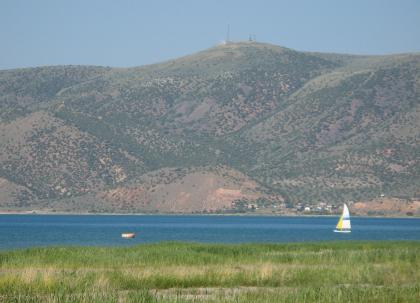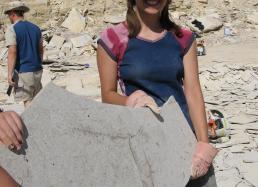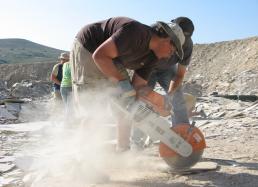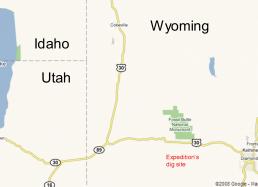6: From Fossil Lake to Bear Lake
We lucked out last night! The rain largely missed us. As is so often the case in the land of the big sky, we were able to see much rain all around us, but we were spared in the eye of the weather system.
This morning we found a lot of fish fossils. One of the nicest was a scarce Notogoneus osculus, or "sand eel," about 20 inches long, found by "Stones and Bones" student Claire LaBarbera (see Photo #1 below.) These fishes are from a family that is marine today, and may indicate that Fossil Lake was somehow connected to the ocean. There are very large and very small specimens of Notogoneus found in the Fossil Lake sediments, but mid-sized individuals are very rare, possibly indicating that this species migrated into the lake from the sea to reproduce in Fossil Lake, and spent their mid years in the ocean.
The students are now involved in all aspects of the operation of this expedition. They've become very proficient in finding the fossils, and also in removing the fossils from the slab so that we can ship them back to Chicago (see Photo #2 below.) Like all "Stones and Bones" classes, this group includes students from many different regions. The current class includes students from Illinois (2), Massachusetts (1), Connecticut (1), Maryland (1), Pennsylvania (1), and Thailand (1).
The students have bonded together as a team that has totally integrated into the Museum staff. They learn something about science, and they learn much about working together on a common project. In the past, such experiences have made long-lasting impressions with students, and some of the previous "Stones and Bones" classes still stay in touch with each other, years after the class is over.
It's about midway through the trip, so it's time to give the students and staff an afternoon off. It's a beautiful day. We'll go to Bear Lake, a large body of water in Utah and Idaho that's about 40 miles west of the quarry (see map photo below). Students can swim, shower, and take a break. It's always nice to see the beautiful blue of this lake as we pass into the Bear Valley through the mountain range that surrounds the lake.
Bear Lake itself is about 10 miles wide by 20 miles long and looks much like how I envision Fossil Lake, except for the absence of volcanoes and tropical vegetation. Late early Eocene Fossil Lake and today's Bear Lake were similar in shape and size, both being elongated in a north-south direction.
Of course, all of the plants and animals today are different. Instead of tsetse flies and palms, we have mosquitoes and aspen trees, and the horses around Fossil Lake had three toes. There also weren't any jet-skis or sailboats on Fossil Lake (see top photo.) Nevertheless, the image of an intermountain lake basin and an active imagination brings to life my mental image of what Fossil Lake might have looked like.
Time to go. More later,
Lance





